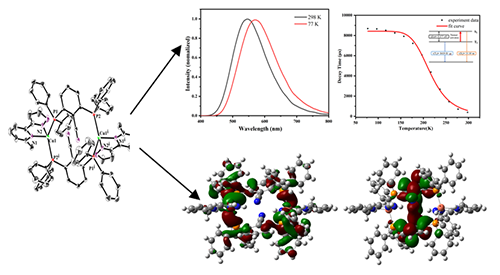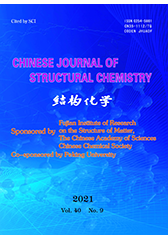Synthesis, Crystal Structure and Photoluminescence of a TADF Dinuclear Cu(I) Complex
TANG Sheng, YU Rong-Min* and LU Can-Zhong*
Chin. J. Struct. Chem. 2021, 40, 1145-1151 DOI: 10.14102/j.cnki.0254-5861.2011-3130
September 15, 2021
Cu(I) complex, crystal structure, photoluminescence, DFT calculation
ABSTRACT
A binuclear Cu(I) complex [Cu(PCNP)(mepypz)]2(BF4)2 (1, PCNP = 2,6-bis(diphenylphosphine)-benzonitrile, mepypz = 2-(1H-pyrazol-3-yl)pyridine) was synthesized from
the reaction of Cu(CH3CN)4BF4, PCNP and mepypz
in CH2Cl2 at room temperature. The compound was
characterized by NMR, UV-vis and X-ray single-crystal structure analysis. It
crystallizes in monoclinic space group P21/c with a = 14.0139(5), b = 11.8149(3), c = 27.1248(10)
Å, β = 96.686(4)°, V = 4460.6(3) Å3, Z = 2, Mr = 1561.97, Dc = 1.163 g/cm3, F(000) = 1600.0, μ = 1.774 mm–1, GOOF = 1.071, the final R = 0.0523 and wR = 0.1412 for 7919
observed reflections with I > 2σ(I). The Cu atoms in the complex are
four-coordinated and adopt a distorted tetrahedral coordination geometry. In
the solid state, the complex exhibits yellowish-green emission with a peak wavelength
of 546 nm, a lifetime of 390 μs, and
a quantum yield of 0.45 at room temperature. The temperature-dependent investigation
of luminescent properties suggests that the complex emits thermally activated
delayed fluorescence (TADF) at room temperature.








